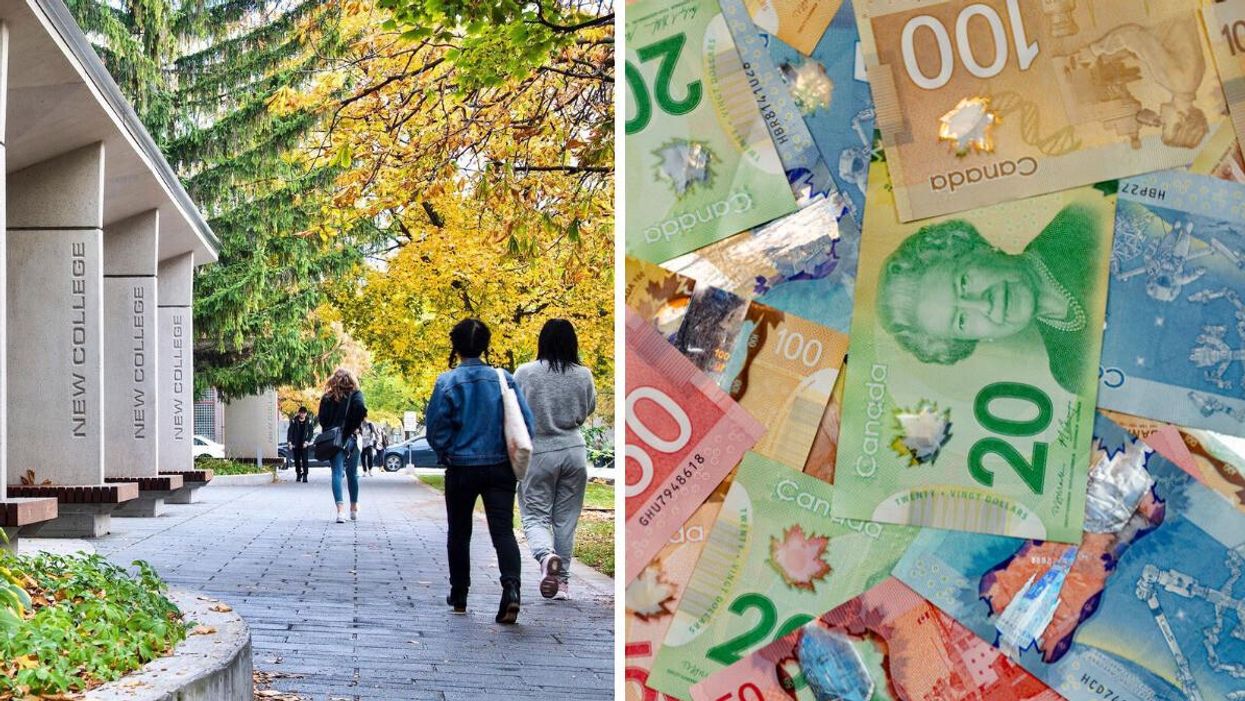Students In Canada Can Get Up To $2K From A Federal Benefit To Pay For Post-Secondary Education
The money can be used to pay for tuition, transportation, rent and more.

Students walking on the University of Toronto campus. Right: Canadian money.
Students in Canada can get money from the government with a federal benefit that's meant to help pay for post-secondary education.
The government of Canada is offering parents with children under 18 years old and students from 18 to 20 years of age the Canada Learning Bond (CLB), which puts up to $2,000 into a Registered Education Savings Plan (RESP).
The CLB can be used to help pay the costs of full-time or part-time post-secondary education including apprenticeship programs, Collèges d'enseignement général et professionnel (CEGEPs), trade schools, colleges and universities.
The federal government contributes up to $2,000 to an RESP for each eligible child.
Those contributions include $500 for their first year of eligibility and then an additional $100 each year the child is eligible up to and including the benefit year in which they turn 15 years old.
While an RESP needs to be opened, no money actually has to be put into the account to get money from the CLB.
Can I get the Canada Learning Bond if I'm over 18 years old?
Students who are over 18 years old can get the CLB from the federal government.
You have from the day your turn 18 years old up until the day before you turn 21 years old to open an RESP and apply for the CLB if you didn't get the benefit when you were a kid but were eligible.
How much money you can get depends on the number of years you were eligible to receive the CLB before you turned 15 years old.
Who qualifies for a Canada Learning Bond?
You could be eligible for the CLB if:
- you were born on or after January 1, 2004,
- you were and still are a resident of Canada, or,
- your parent or former primary caregiver applied for the CLB and had a low adjusted income for at least one year before you turned 15.
The amount of money you can get from the CLB will also depend on the number of children in your family before you turned 15 years old and the adjusted income of your primary caregiver.
How do I claim my Canada Learning Bond?
If you were eligible for the CLB as a child but didn't get it, you can apply for it yourself once you turn 18.
To request the CLB, you need to have a valid social insurance number and have opened up an RESP.
After the government deposits the CLB into your RESP, you can take the money out to help with education expenses right away or keep it in your RESP for future education.
An RESP can actually stay open for 35 years!
Whenever you choose to withdraw the CLB money, you have to contact your financial institution and request an educational assistance payment.
To get an educational assistance payment, you have to be enrolled in full-time or part-time studies at an eligible school in Canada or abroad and provide proof of enrollment.
The CLB can be used to help pay for expenses such as tuition, books, tools, transportation and rent.
Do I have to pay back the Canada Learning Bond?
CLB money gets returned to the federal government only if the RESP is closed and you didn't end up getting a post-secondary education.
That applies if your parent got CLB payments for you when you were a child or if you got it for yourself after you turned 18 years old.
If you use the money to help pay for your education, it doesn't need to be paid back to the government.
What other federal benefits can students get in 2023?
Students can get a lot of money from the federal government in 2023 including the climate action incentive payment, doubled student grant money, the Canada Housing Benefit top up and more.
This article's cover image was used for illustrative purposes only.
- Students In Canada Can Get Federal Benefits In 2023 & Here's How Much Money Is Available ›
- Canadian Parents Can Get Up To $2K From The Feds By Opening A Savings Plan For Their Kids ›
- Canadian Parents Can Get Up To $7.2K For Their Kids By Putting Money Into A Savings Plan ›
- The Federal Government Made Changes To Student Loans In 2022 & Here's What You Might've Missed - Narcity ›
- Students In Canada Can Get Money From The Canada Housing Benefit To Help Pay For Rent - Narcity ›
- The Federal Government Is Planning To Make Changes To Student Grants & You Could Get Over $4,000 - Narcity ›
- RESPs In Canada Are Set To Be Revamped & Here's What The Feds Want To Change - Narcity ›
- Here's How The Federal Government Is Planning To Help Students Afford Post-Secondary Education - Narcity ›
- Benefits, Grants & Payments From The Feds That Can Help Parents With The Cost Of Raising Kids - Narcity ›
- Canada's Climate Action Incentive Payment Is Being Expanded & Here's Who Is Getting Money - Narcity ›
- 7 Benefits, Credits & Payments From The Federal Government You Can Get As A Single Person - Narcity ›
- 5 Ways Students In Canada Can Get Help From The Federal Government This School Year - Narcity ›
- These Are The Federal Benefits, Payments & Credits You Could Get Money From In 2024 - Narcity ›
- 13 Student Discounts You Can Get In Canada If You're Going To University Or College This Fall - Narcity ›
